







 |
 |
 |
 |
 |
 |
 |
 |


|
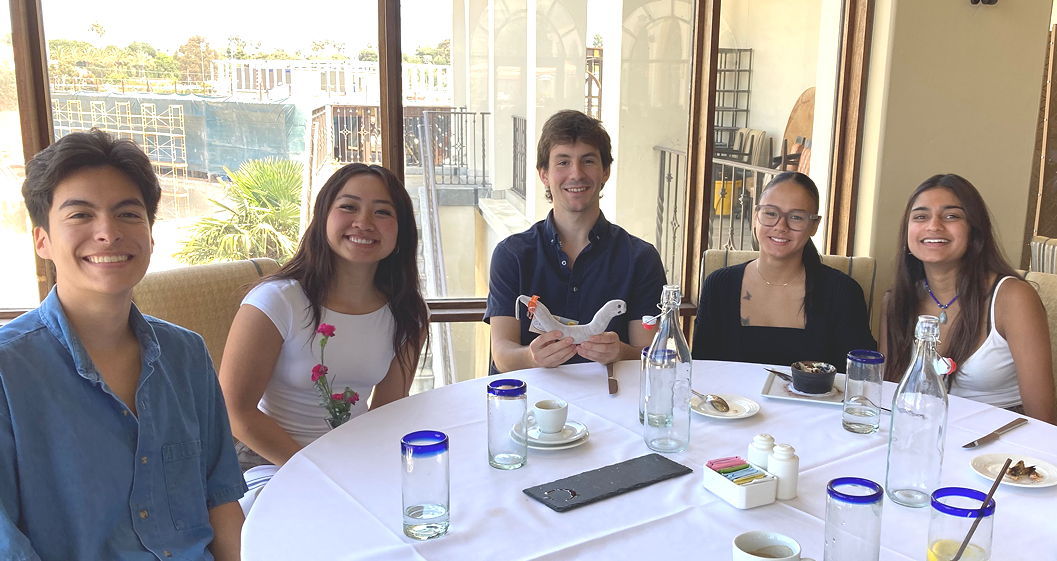 Left to right: David Lopez, Ella Crisologo, Jorge Morgan, Kaitlyn Zierke, Kaya Patel |
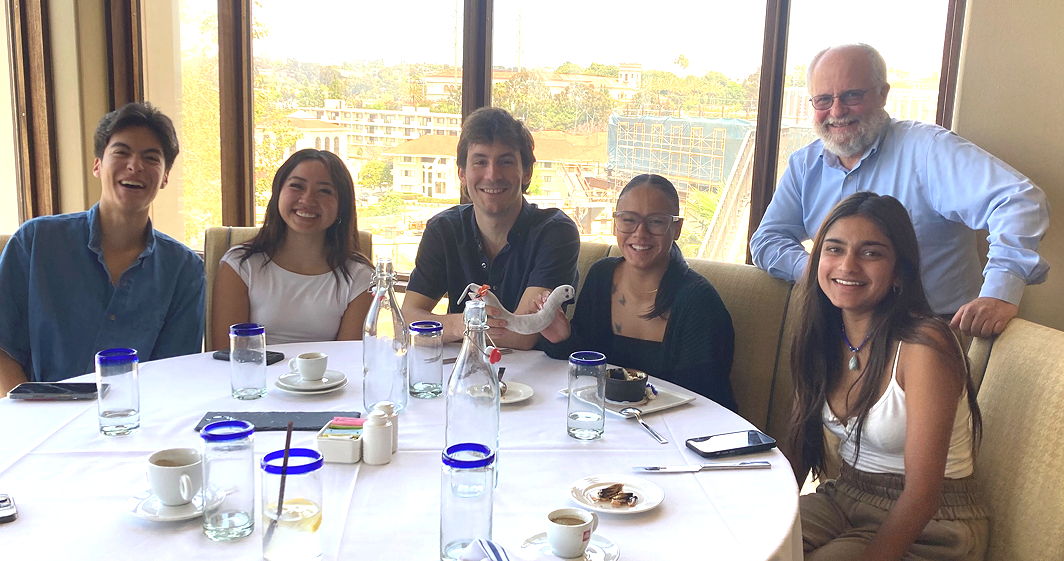 |
Special Alumni News:
 |
Another amazing coincidence for 2010 alumni Ryan Kast (L) & Juan Velasquez (R) - both worked for a few years after graduation, then without coordination, started in the same PhD program in Neuroscience at USC. In the May 2017 issue of ACS Chemical Neuroscience, they both published articles from their PhD research - and both on serotonin-related topics. Effect of Maternal ±Citalopram Exposure on P11 Expression and Neurogenesis in the Mouse Fetal Brain |
Some Recent Lab Alumni
Complete list of Loer lab alumni / Loer lab gallery
Jorge Morgan '24 joined the lab in Fall 2023 working on serotonin neuron evolution in nematodes, and is a co-author on a manuscript on monoaminergic neurons and their function in P. pacificus in preparation with the Hong lab at CSU Northridge. Theresa Medina '23 joined the lab in Fall 2021 and worked on the cha-1 gene of Pristionchus pacificus, and is a co-author on a manuscript on monoaminergic neurons and their function in P. pacificus in preparation with the Hong lab at CSU Northridge. Madeleine Neff '23 joined the lab in Fall 2022 after taking a spring 2022 'Research Project' class, and then continued work started there on the unc-42 gene of P. pacificus. MK Riley joined the lab in Spring 2022 and worked with Theresa Medina on the cha-1 gene of Pristionchus pacificus. Sidney Tookes '22 joined the lab in Fall 2020 working with Hayley Lee '21 on the unc-86 gene of Pristionchus pacificus. Besides being a Biology major, Sidney also works in commercials and as a model. Tanner Winthrop joined the lab in the 'bioinformatics group' in Fall 2019 working with Emily Kemker '20 on the 'neuronal genome' of the satellite model organism Pristionchus pacificus, a relative of the better known nematode C. elegans. Haley Ohlson '22 joined the lab in Spring 2020 and wrote her honor's thesis on the history of gene duplication and loss of bas-1 and bas-1-like AADC genes in the genus Caenorhabditis, following up on a story from an old lab paper co-authored with Emily Hare '01. Haley was also on the USD women's swimming & diving team. Haley is currently a research assistant in a lab at Boston Children's Hospital, Harvard Medical School. Hayley Lee '21 joined the lab in Fall 2020 working with Sidney Tookes on the unc-86 gene of Pristionchus pacificus. She is currently in medical school at Penn State. Sydney Wong '21 joined the lab in Fall 2019 to work on neuronal specification in the satellite model organism Pristionchus pacificus, a relative of the better known nematode C. elegans. She is currently in medical school at the University of Washington. Laine Cargill '20 joined the lab in Fall 2019 and worked with Dominick Hellen on the regulation of biopterin (BH4) synthesis (in C. elegans) by the gfrp-1 gene, which encodes GTPCH feedback regulatory protein. Dominick Hellen '20 joined the lab in Fall 2019 and worked with Laine Cargill on the regulation of biopterin (BH4) synthesis (in C. elegans) by the gfrp-1 gene, which encodes GTPCH feedback regulatory protein. Emily Kemker '20 joined the lab's "bioinformatics group" in Fall 2019 and analyzed neurotransmitter-related genes of the 'neuronal genome' of Pristionchus pacificus. Camille Morales '19 joined the lab Fall 2016, and later spent a semester abroad in Cambodia studying elephant foraging (very cool). She worked on biopterin (BH4) synthesis with Tatiana (below). She ran cross country at USD, and enjoys hiking in her home state of Colorado. Tatiana Moreno '19 (Dec) joined the lab in Spring 2017 working on the regulation of biopterin (BH4) synthesis in C. elegans with Camille (above), particularly in demonstrating the role of C. elegans GFRP (GTPCH feedback regulatory protein) in inhibiting GTP cyclohydrolase (GTPCH/CAT-4) to regulate tetrahydrobiopterin levels. She is from Madrid, Spain and enjoys playing volleyball. She presented a poster on her work at the International C. elegans meeting at UCLA in June 2019. After graduating, she worked in Malene Hansen's lab at the Sanford Burnham Prebys Institute, and then transitioned to its PhD program in Caroline Kumsta's lab. Addison Rodgers '18 joined the lab Spring 2016, studied abroad in Fall 2016, and returned to continue work on the function of the BH4-dependent lipid metabolic enzyme AGMO by examining the phenotype of agmo-1 mutants. Jalen Paulos '18 joined the lab in Fall 2017, and studied the role of Wnt signaling genes in the specification of male-specific serotonergic neurons found in the central body. He took both Animal Development (Bio 376) and Techniques in Molecular Biology (Bio/Chem 330) prior to joining the lab where he did similar work, and made DNA constructs to used to block gene function by RNA interference. He also served as a lab assistant for the following year's Bio 376 class.
Jalen went on to medical school and a medical residency at UNLV. Daniel Sykora, '16 (Dec), worked in the lab for a year, starting in Fall 2015, and used bioinformatics and computational chemistry (with Dr. Joachim Lätzer) to examine how biopterin synthesis may be regulated in C. elegans by GFRP (GTPCH feedback regulatory protein) binding with GTP cyclohydrolase (GTPCH/CAT-4).
As a USD Honors program student, he wrote an Honors thesis on his work, and presented an Honors seminar on Thursday, December 1, 2017. Dr. Jim Gump, Honors program director, praised him for delivering 'one of the most accessible honors seminars in science' he has heard. Congratulations!
Daniel joined the inaugural class of the Mayo Clinic School of Medicine affiliated with Arizona State University in Fall 2017; after getting his MD, he went on to a residency in internal medicine at the Mayo Clinic in Minnesota. Alec Knapp, '16, worked in the lab for over a year searching for genes encoding the missing enzyme(s) catalyzing the final steps in C. elegans biopterin synthesis, using both computational chemistry to model predicted proteins (in collaboration with Joachim Lätzer in Chemistry & Biochemistry) and examining C. elegans mutants. He was a SURE Scholar in the lab during summer 2015, and is a co-author on a poster presented at the 2015 International C. elegans Meeting at UCLA.
Alec presented his senior capstone seminar on Friday, April 22, 2016 and did a great job! [Photos from the seminar]
Alec has worked in biotech as a research associate and scientist in Oregon and Washington since 2016. Amanda Skinner, '16, is an aspiring bioinformatician who joined the lab in Spring 2016 before graduation and worked to reanalyze published microarray datasets by various clustering methods to see what genes are regulated similarly to biopterin synthesis & regeneration genes (such as cat-4, ptps-1, qdpr-1 & pcbd-1). Jesse Cottle, '15, a former marine who served in Afghanistan, worked in the lab for about a year on biopterin-deficient mutants, and is acknowledged for his contributions to our 2015 Genetics paper. (Shown here with wife Kelly and newborn daughter Grace.) He is now a Physician Assistant in Twin Falls, Idaho. Max Ofoma, '15 was a business major and pre-med who worked in the lab for over a year, characterizing the hypersensitivity
of biopterin synthesis and agmo-1 gene mutants, and is acknowledged for his contributions to our 2015 Genetics paper. He attended medical school at the School of Medicine, Indiana University, and went into a psychiatry residency in Indiana.

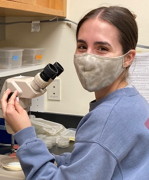
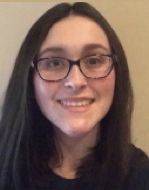
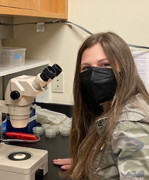
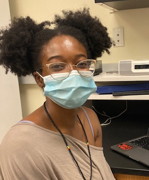
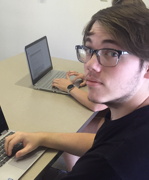
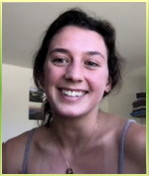


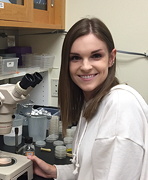



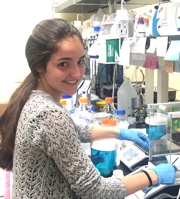
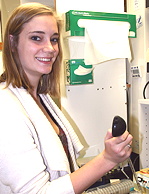
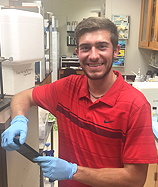

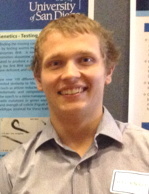

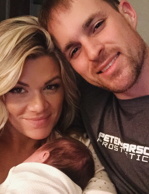
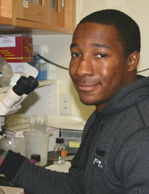
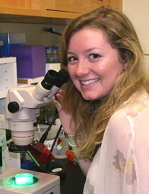
Rachel Lex, '14 worked on the role of Wnt signaling in the specification of male-specific serotonergic neurons found in the central body. Rachel was a McNair scholar who also worked in the C. King lab at UCSD during her time at USD. She got her PhD in cell-molecular biology at UT Austin, and then worked as a postdoctoral fellow in the Beronja lab at the Fred Hutch Cancer Center in Seattle.
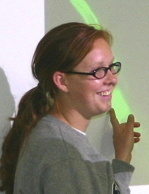
Erin Williams, '13, worked in the lab
all four years of her time at USD. She is a co-author on a paper on the specification of male-specific serotonergic neurons found in the central body, which are partly
specified by the homeotic complex gene lin-39 (Kalis et al., 2014). She is seen here giving a talk about her summer research at a gathering of fellow USD research students (see was a SURE grant recipient). Besides working
in the lab, Erin ran cross country for USD, served as a preceptorial assistant, and resident advisor in the dorms. She received her PhD from MD Anderson, UT Houston in 2018.
Andrew Chisholm, Division of Biological Sciences, UC San Diego. One interest of the Chisholm Lab is epithelial wound healing, which they study in the skin of C. elegans; we worked with them in characterizing the expression patterns of biopterin synthetic enzyme and the AGMO genes in C. elegans.
Oliver Hobert, Dept. of Biological Sciences & HHMI, Columbia University, NY. We are currently collaborating with the Hobert lab (and Sommer lab) to fully characterize the nervous system of the satellite model organism (nematode) Pristionchus pacificus, including the expression and function of two terminal selector transcription factors with well-characterized functions in C. elegans, unc-3 and unc-86.
Jonathan Hodgkin, Dept. of Biochemistry, University of Oxford, UK. [Now an Emeritus Fellow] We began working with the Hodgkin lab when they discovered that several mutants affecting pathogen susceptibility in C. elegans had mutations in the worm agmo-1 gene.
Ray Hong, Dept. of Biology, California State University, Northridge. We are collaborating with the Hong lab (and Hobert lab) on the function and expression of the Pristionchus cat-1 (vesicular monoamine transporter, VMAT) gene.
Joachim Lätzer, Southwestern Community College (previously of Dept. of Chemistry & Biochemistry, USD). We modeled structures of C. elegans proteins to 1) identify candidates enzymes that may perform the final reduction steps in biopterin synthesis and 2) understand how biopterin synthesis may be regulated by the protein GFRP.
Aurora Martinez, Dept of Biomedicine, University of Bergen, Norway. The Martinez lab biochemists study the function of aromatic amino acid hydroxylase (AAH) enzymes, especially phenylalanine hydroxylase (PAH). Dysfunction of PAH in humans results in phenylketonuria (PKU); we worked with the Martinez lab on C. elegans PAH, and on biopterin, a cofactor required for AAH function.
Einhard Schierenberg, Zoological Institute, University of Cologne (Köln), Germany. [Dr. Schierenberg is deceased.] The Schierenberg lab studied the evolution of nematode embryogenesis. We worked with them to identify the embryonic origins of specific serotonergic neurons in nematode relatives of C. elegans and also in characterizing an interesting nematode (Propanagrolaimus sp.) found in mud of the San Diego river.
Ralf Sommer, Max Planck Institute for Evolutionary Biology, Tübingen, Germany. We are currently collaborating with the Sommer lab (and Hobert lab) to characterize the expression and function of two terminal selector transcription factors with well-characterized functions in C. elegans, unc-3 and unc-86, in the satellite model organism (nematode) Pristionchus pacificus. The Sommer lab is the 'mother ship' for Pristionchus research - Dr. Sommer first developed this worm as a new model organism for evolutionary developmental biology just over 20 years ago.
Paul Sternberg, Division of Biology, California Institute of Technology, Pasadena, CA. We worked with the Sternberg lab comparing the patterns of serotonergic and dopaminergic neurons and behaviors regulated by serotonin in six nematode relatives of C. elegans, culmininating in a paper published in BMC Neuroscience.
Ernst Werner, Division of Biological Chemistry, Innsbruck Medical University, Austria. Members of the Werner lab are biochemists, expert in biopterins. They identified the human gene encoding alkylglycerol monooxygenase (AGMO), a third type of biopterin-dependent enzyme. Previously, this lipid metabolic enzyme was known only as an enzymatic activity. We worked with them on C. elegans biopterins, biopterin synthetic enzyme genes, and the C. elegans AGMO.
Jennifer Wolff, Dept. of Biology, Carleton College, Northfield, MN. The Wolff lab is also populated primarily by undergraduates (like us). They are also studying the development of male serotonergic CP neurons, with an emphasis more on sex-related neural specification. We began working together after discovering significant overlap in some of our interests and experiments., subsequently publishing a paper together on this work.